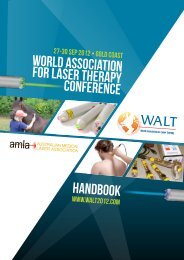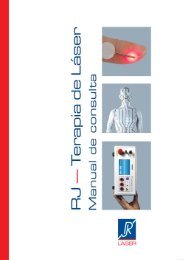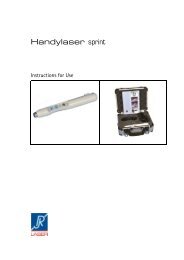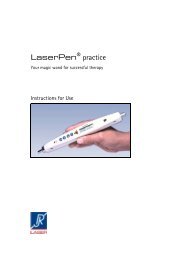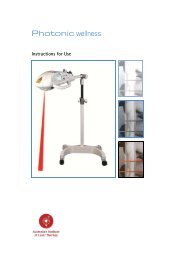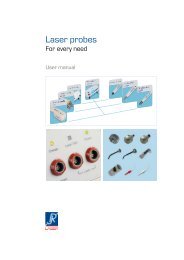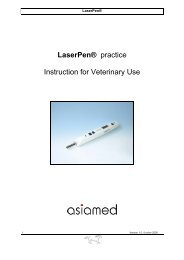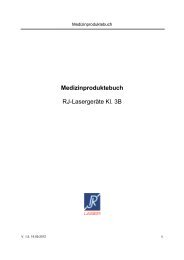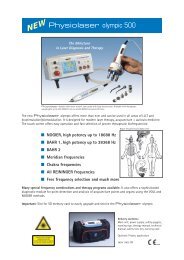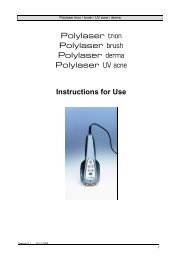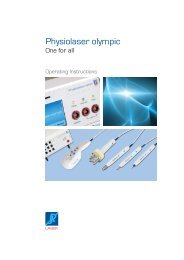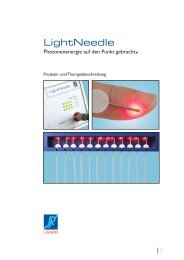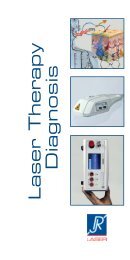LightNeedle - RJ Laser
LightNeedle - RJ Laser
LightNeedle - RJ Laser
You also want an ePaper? Increase the reach of your titles
YUMPU automatically turns print PDFs into web optimized ePapers that Google loves.
302<br />
SONK. 11–16 However, clinical data on its effectiveness are<br />
currently lacking. For the first time, we describe the treatment<br />
of a 63-year-old patient with SONK using low-level<br />
laser irradiation.<br />
Case Report<br />
A 63-year-old man presented to sports medicine consultation<br />
with pain in the right medial femur radiating to the<br />
medial joint cavity. The complaints had first developed a<br />
year before, were aggravated by exercise, ceased spontaneously,<br />
then recurred during exercise on the treadmill 3 wk<br />
earlier. Up to that point the patient had worked out 1–2 h<br />
daily. In recent months, however, exercising was possible<br />
only with limitations. This otherwise healthy patient denied<br />
preceding trauma and had no history of diabetes mellitus or<br />
other metabolic disorders.<br />
On clinical examination the medial distal femur of the<br />
knee joint was sensitive to pressure. The circumference measurement<br />
at the joint cavity revealed a left-to-right proportion<br />
of 36.5 cm to 35 cm. No other side discrepancies,<br />
swelling, or hyperthermia were apparent. All relevant functional<br />
tests of the knee were normal. With the exception of<br />
increased homocysteine values, all relevant laboratory values,<br />
including the rheumatoid factors, were unremarkable.<br />
Furthermore, predisposing factors associated with secondary<br />
osteonecrosis, such as long-term glucocorticoid therapy,<br />
renal transplantation, SLE, alcohol abuse, caisson<br />
decompression sickness, Gaucher’s disease, and hemoglobinopathies<br />
could be excluded.<br />
The magnetic resonance imaging (MRI) examination of the<br />
right knee joint performed 2 d later (on March 16, 2005) revealed<br />
Morbus Ahlbäck (spontaneous osteonecrosis of the<br />
knee, stage III) at the coronary fat-suppressed PD TSE se-<br />
A<br />
BANZER ET AL.<br />
quence (Fig. 1). There was a linearly demarcated subcortical<br />
focus at the medial femur condyle with adjacent spongiosa<br />
edema (necrotic zone) reaching deep into the bone marrow.<br />
There was no osteochondritis dissecans. Furthermore, chondral<br />
irregularities were present at the medial femur condyle,<br />
with a lesion consisting of less than 50% of the normal cartilage<br />
thickness, in accordance with grade II chondropathy.<br />
The frontal view showed centrally and along the medial<br />
condyle a retropatellar cartilage lesion also in accordance<br />
with grade III chondropathy. Irritation at the lower portion<br />
of the medial retinaculum was also revealed.<br />
We explained to our patient the various therapeutic alternatives,<br />
in particular the conservative options, and recommended<br />
no or only very minor surgical intervention. The patient<br />
decided on a conservative course of laser therapy. The<br />
therapy was conducted with the commercially available<br />
<strong>Laser</strong>needle ® System (Germany).<br />
The device consists of eight laser needles, each attached<br />
to the end of an optical fiber. <strong>Laser</strong> diodes were used for the<br />
light source, and they emit red light at a wavelength of 685<br />
nm and infrared light at a wavelength of 885 nm (bichromatic<br />
emission) in continuous-wave mode with an output<br />
power of 35 mW per laser needle. The fiber core diameter<br />
was 0.5 mm, resulting in a power density of 17.8 W/cm 2 per<br />
laser needle. The use of two wavelengths with different scattering<br />
properties has the advantage that the tissue light absorbance<br />
is more homogeneous, which is critical to achieve<br />
the optimal therapeutic effect. The laser needles were not inserted<br />
into the skin, but were taped to the skin along the distal<br />
part of the femur in the region of the medial condyle and<br />
joint cavity with the patient lying relaxed on his back. Therapy<br />
sessions lasted 60 min and were performed daily over a<br />
period of 3 mo. The total irradiation dose emitted by the eight<br />
laser needles in each 60-min treatment session was 1008 J.<br />
FIG. 1. These MRI images, made March 16, 2005, are a coronary fat-suppressed PD TSE sequence. (A) Axial and (B) frontal<br />
images, showing a linearly subcortical focus at the medial femur condyle with adjacent spongiosa edema (necrotic zone)<br />
reaching deep into the bone marrow.<br />
B



